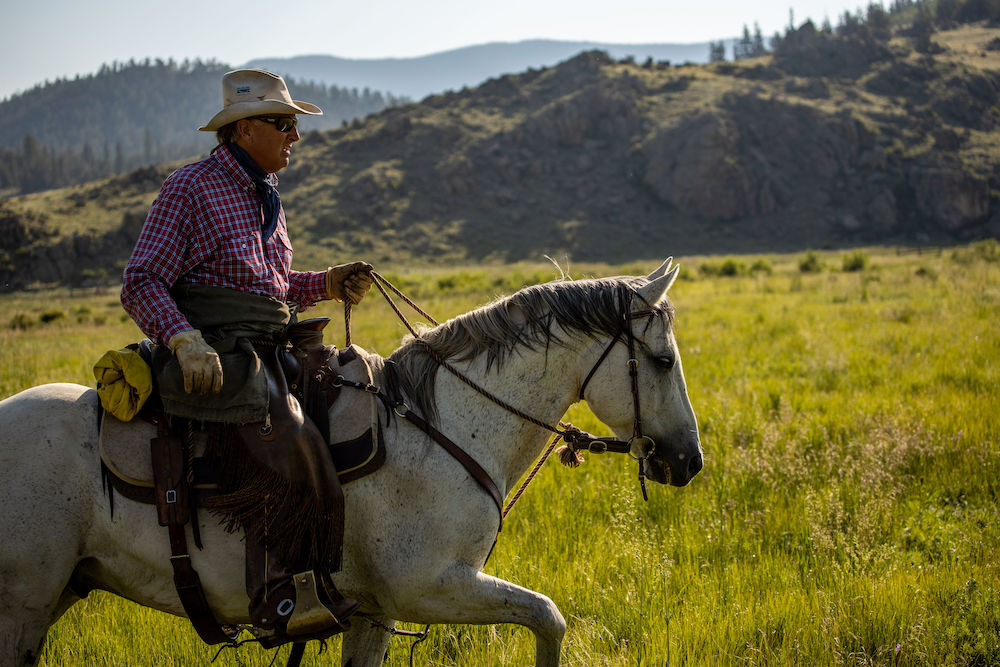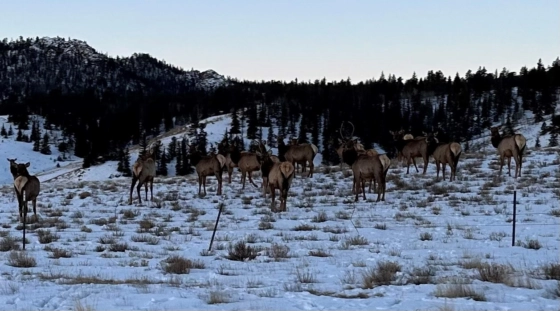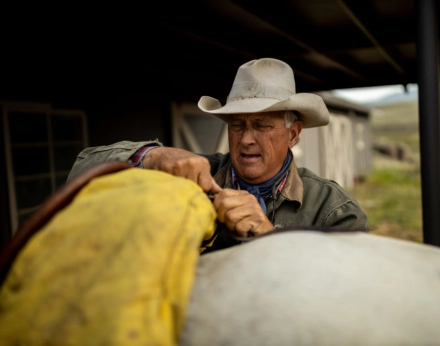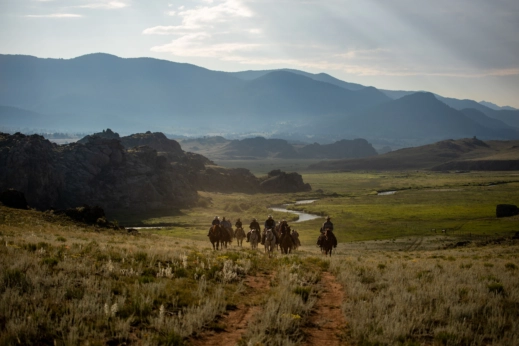At this Colorado ranch, elk are a benefit.

At Eagle Rock Ranch in Jefferson, Colorado, the elk start to gather at dusk. “I’ll be driving up the road, and the herd will be on the side, almost like they’re waiting to come and spend the night eating here,” says Dave Gottenborg with a chuckle.
Gottenborg is working to create a habitat on his ranch that sustains the elk population. The ranch sits on the migratory path of the big animals, and every winter, hundreds of them travel through Eagle Rock looking for food as they move from higher to lower elevations. You could see their presence as a wildlife management success story or a nuisance, depending on how you look at them. Maybe a bit of both.
“Elk can provide an indicator of how well habitats are functioning,” says Karie Decker, director of wildlife and habitat for the Rocky Mountain Elk Foundation, which works to ensure the animals have the habitat they need to thrive. “They have a direct role on vegetation through herbivory and seed dispersal, create wallows and serve as prey and carrion for many other wildlife species.”
According to the Rocky Mountain Elk Foundation, before Europeans settled in North America, more than 10 million elk were roaming around the US and parts of Canada, but due to overhunting and habitat loss, their numbers dwindled to 40,000 at the turn of the 20th century.
That’s when conservationists and government agencies began efforts to restore elk populations through protected areas and regulated hunting. Today, Colorado is home to 280,000 elk, the biggest population in the world. Despite these efforts, maintaining that population is a challenge.

Every winter herds of elk come through Eagle Rock Ranch in search of food. (Photo courtesy of Eagle Rock Ranch)
Threats to the elk include everything from climate change to manufactured barriers that can stifle their daily and seasonal movements, land development, traffic, increased human recreational activity, fencing and conflicts with human activities.
“In Colorado, elk and many other species had a very challenging winter in 2022-2023, with a deep snowpack for an extended period, significantly reducing the population in northwest Colorado,” says Decker. “Other challenges to elk across various states include development and the loss of habitat, lack of or low-quality forage, drought, disease and social tolerance.”
Eagle Rock Ranch has been in operation, primarily as a cow-calf operation, for more than 150 years, but Gottenborg, who runs the ranch with his wife, Jean Gottenborg, daughter Erin Michalski and son-in-law Matt Michalski, is relatively new to Eagle Rock, acquiring the ranch about 12 years ago. The elk came with it.
“My predecessor fought them for years,” says Gottenborg. “He did probably everything a landowner could legally do to chase elk off the property, with mixed results. He had propane cannons and salt and pepper shells, and he would get into these big arguments with the Forest Service and CPW [Colorado Parks and Wildlife].”

The Gottenborgs are trying to create safe passage and habitat for the migrating elk. (Photo courtesy of Eagle Rock Ranch)
Elk are not small visitors. Males can weigh up to 700 pounds and stand five feet at the shoulder, females up to 500 pounds and 4-1/2 feet at the shoulder.
“They are very large, determined eaters,” says Kara Van Hoose, Northeast Region public information officer for CPW. “They will devour hay and other grains left outside for domestic animals and livestock. Elk are known to be destructive in their pursuit of food, toppling over containers, ruining fences and other infrastructure and eating large swaths of crops.”
Still, the Gottenborgs decided to welcome the elk, hoping to make them a benefit to the ranch. Since buying the ranch, the Gottenborgs have been working to diversify their income with the goal of keeping themselves and other ranchers on the land and maintaining the open landscapes. They’ve dipped their toes into agritourism with curated experiences, including fly fishing, ranch tours and eco-tours, and they see the elk as another income stream.
Programs such as Elk Rent in Montana, from the nonprofit Property and Environment Research Center, and the USDA’s Migratory Big Game Initiative in Wyoming, Idaho and Montana pay landowners for providing elk habitat. While there isn’t a program set up yet to do the same in Colorado, the Gottenborgs are in talks with organizations that will pay for the elk to have forage access to their pastures in the winter.
During the winter months when the elk are migrating through the property, the Gottenborgs’ cattle are in Nebraska, so the Gottenborgs don’t need to worry about cows and elk competing for food. By the time the cows are back on the ranch, the elk have moved back up to higher ground. To make it easier for the elk to graze without the risk of getting caught in their fences, they’ve started making modifications to make it easier for them to move up and down the valley.
“The hope here, too, is that my neighbors are watching me. That they’re following what we’re doing and we can expand the concept, so, eventually, there’s 10 or 12 miles of this valley opened up in terms of easier access,” says Gottenborg.

The Gottenborgs are attempting to diversify the ranch’s income with the elk, agritourism tours and more. (Photo courtesy of Eagle Rock Ranch)
Elk-friendly fencing that can be laid down flat on the ground to support seasonal wildlife passage is expensive. Still, the Gottenborgs believe there is enough interest in the forage access that they’ll be able to make more modifications. They’re not laying down all of the fences, but they can easily track the migration patterns of the elk in the snow, so they lay down specific fencing sections while keeping their gates open.
In 2023, the Gottenborgs also installed five large, shallow-pool structures that hold fresh water with pumps powered by solar panels. The drinkers, as the Gottenborgs call them, provide water in the higher elevation pastures during the warmer months and the shoulder seasons where natural water sources aren’t present and help to distribute wildlife across the landscape better. They’re hoping to install additional drinkers this year.
“The elk have been here a long time, and we’re trying to change our approach to make them an asset,” says Gottenborg.
Wonderful wildlife news for a change!
Thank you for helping God’s elk, deer, etc. I have been a avid hunter, fisher- woman, mountain climber, outdoors woman and raised my 2 daughters by myself, to love all wilderness type activities. I taught them you don’t shoot/kill a animal unless you are putting it in the freezer! It was game meat that sustained us all of their childhoods. I want to say I really appreciate you’al taking care of wildlife! It seems its always been farmers/ranchers vs. Wildlife. I hope you can teach others to do the same for our wildlife. I had to give up all that… Read more »
It will be ranchers like you to lead the way for others to learn to co-exist with all types of wildlife that need their ancestorial lands before humans. There are ways to live and for your ranch to thrive. Without ranching, these lands would be destroyed with houses and shopping centers. Thank you for what you’re doing!
Fabulous article 💕